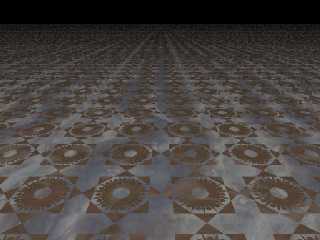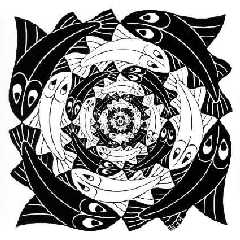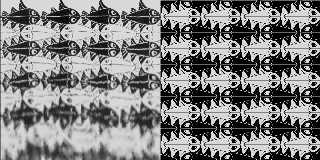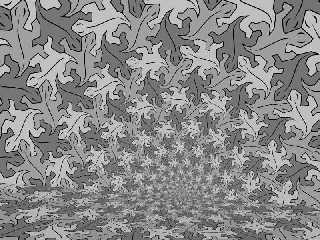 |
 |
|
 |
|
 |
|  |
|  |
|
 |
|
 |
|  |
|  |
|
 |
"Bob H." wrote:
>
> ( I still refuse to believe a human being was able to do this type of
> pattern magic until I see proof in the way of scripting) :-D
>
I think I'm on to his methods, although I probably lack the 3D perception to
imitate his work.
Here's a little "function pattern" for ya (no image maps!). It's a 2D pattern,
but that's just because I lacked inspiration for a 3D one. The basic principle
is very simple... Perhaps you can guess how it was made? :)
--
Margus Ramst
Personal e-mail: mar### [at] peak edu edu ee
TAG (Team Assistance Group) e-mail: mar### [at] tag ee
TAG (Team Assistance Group) e-mail: mar### [at] tag povray povray org org
Post a reply to this message
Attachments:
Download 'f_pat.jpg' (47 KB)
Preview of image 'f_pat.jpg'

|
 |
|  |
|  |
|
 |
|
 |
|  |
|  |
|
 |
"Margus Ramst" <mar### [at] peak edu edu ee> wrote in message
news:39E65BBD.81BBC314@peak.edu.ee...
| "Bob H." wrote:
| >
| > ( I still refuse to believe a human being was able to do this type of
| > pattern magic until I see proof in the way of scripting) :-D
| >
|
| I think I'm on to his methods, although I probably lack the 3D perception
to
| imitate his work.
| Here's a little "function pattern" for ya (no image maps!). It's a 2D
pattern,
| but that's just because I lacked inspiration for a 3D one. The basic
principle
| is very simple... Perhaps you can guess how it was made? :)
I'll guess a overall spherical patterned pigment (or texture) map using
triangle pattern for outermost part and just clear to opaque central part,
with radial pattern for the spokes and dots. But then I have no idea how
you actually got the spokes and dots made.
It's a bit much for my feeble mind.
It's good I assure you but nothing like those supposedly mathematically made
(?!) curves and shapes in such a rendition of a Escher drawing as what
Wlodzimierz has shown.
Bob ee> wrote in message
news:39E65BBD.81BBC314@peak.edu.ee...
| "Bob H." wrote:
| >
| > ( I still refuse to believe a human being was able to do this type of
| > pattern magic until I see proof in the way of scripting) :-D
| >
|
| I think I'm on to his methods, although I probably lack the 3D perception
to
| imitate his work.
| Here's a little "function pattern" for ya (no image maps!). It's a 2D
pattern,
| but that's just because I lacked inspiration for a 3D one. The basic
principle
| is very simple... Perhaps you can guess how it was made? :)
I'll guess a overall spherical patterned pigment (or texture) map using
triangle pattern for outermost part and just clear to opaque central part,
with radial pattern for the spokes and dots. But then I have no idea how
you actually got the spokes and dots made.
It's a bit much for my feeble mind.
It's good I assure you but nothing like those supposedly mathematically made
(?!) curves and shapes in such a rendition of a Escher drawing as what
Wlodzimierz has shown.
Bob
Post a reply to this message
|
 |
|  |
|  |
|
 |
From: Wlodzimierz ABX Skiba
Subject: Re: fished onion - how do this (2 img - 223KB bu)
Date: 13 Oct 2000 03:56:09
Message: <39e6c019@news.povray.org>
|
|
 |
|  |
|  |
|
 |
Bob H. wrote in message <39e6364c@news.povray.org>...
>( I still refuse to believe a human being was able to do this type of
>pattern magic until I see proof in the way of scripting) :-D
1. take original (first attached image)
2. flat this (left side of second attached image)
3. hand code best imitation from primitives (right side of second
attached image)
4. round this back to onion (attachment in 39e49cb3@news.povray.org)
:-D
ABX
Post a reply to this message
Attachments:
Download 'round.jpg' (33 KB)
Download 'flat.jpg' (192 KB)
Preview of image 'round.jpg'

Preview of image 'flat.jpg'

|
 |
|  |
|  |
|
 |
From: Bob H
Subject: Re: fished onion - how do this (2 img - 223KB bu)
Date: 13 Oct 2000 04:18:15
Message: <39e6c547@news.povray.org>
|
|
 |
|  |
|  |
|
 |
"Wlodzimierz ABX Skiba" <abx### [at] abx art art pl> wrote in message
news:39e6c019@news.povray.org...
| Bob H. wrote in message <39e6364c@news.povray.org>...
| >( I still refuse to believe a human being was able to do this type of
| >pattern magic until I see proof in the way of scripting) :-D
|
| 1. take original (first attached image)
| 2. flat this (left side of second attached image)
| 3. hand code best imitation from primitives (right side of second
| attached image)
| 4. round this back to onion (attachment in 39e49cb3@news.povray.org)
|
| :-D
Okay, thankyou for explaining. I still don't understand it completely but
the CSG of shapes makes more sense than the wild imaginings I was thinking
of. I just can't follow step by step either, it's amazing regardless of
whether I know how it was done or not.
Bob pl> wrote in message
news:39e6c019@news.povray.org...
| Bob H. wrote in message <39e6364c@news.povray.org>...
| >( I still refuse to believe a human being was able to do this type of
| >pattern magic until I see proof in the way of scripting) :-D
|
| 1. take original (first attached image)
| 2. flat this (left side of second attached image)
| 3. hand code best imitation from primitives (right side of second
| attached image)
| 4. round this back to onion (attachment in 39e49cb3@news.povray.org)
|
| :-D
Okay, thankyou for explaining. I still don't understand it completely but
the CSG of shapes makes more sense than the wild imaginings I was thinking
of. I just can't follow step by step either, it's amazing regardless of
whether I know how it was done or not.
Bob
Post a reply to this message
|
 |
|  |
|  |
|
 |
|
 |
|  |
|  |
|
 |
"Bob H." wrote:
>
> I'll guess a overall spherical patterned pigment (or texture) map using
> triangle pattern for outermost part and just clear to opaque central part,
> with radial pattern for the spokes and dots. But then I have no idea how
> you actually got the spokes and dots made.
Nope. Similar to what Wlodzimierz did, but this is just a quickie. CSG of a few
boxes, torus, spheres & cones; turned into an object pattern and tiled.
Besides, apparently his patterns are 2D too - I was truly stumped as to how he
managed a 3D-tilable Escher pattern ;) I'm not sure how he got more than 2
possible pattern values in his previous works, though...
--
Margus Ramst
Personal e-mail: mar### [at] peak edu edu ee
TAG (Team Assistance Group) e-mail: mar### [at] tag ee
TAG (Team Assistance Group) e-mail: mar### [at] tag povray povray org org
Post a reply to this message
|
 |
|  |
|  |
|
 |
|
 |
|  |
|  |
|
 |
Margus Ramst wrote in message <39E6FBC3.74782879@peak.edu.ee>...
> I'm not sure how he got more than 2
> possible pattern values in his previous works, though...
You mean this ?
#local FunPig1=function{pigment{object{Obj1 color 0 color 1/3}}}
#local FunPig2=function{pigment{object{Obj2 color 0 color 2/3}}}
#local FunPig3=function{pigment{object{Obj3 color 0 color 1}}}
#local EscherFunction=function{FunPig1+FunPig2+FunPig3}
ABX
Post a reply to this message
|
 |
|  |
|  |
|
 |
From: Wlodzimierz ABX Skiba
Subject: Re: fished onion - how do this
Date: 13 Oct 2000 10:39:19
Message: <39e71e97@news.povray.org>
|
|
 |
|  |
|  |
|
 |
Wlodzimierz ABX Skiba wrote in message <39e6c019@news.povray.org>...
>1. take original (first attached image)
>2. flat this (left side of second attached image)
>3. hand code best imitation from primitives (right side of second
>attached image)
>4. round this back to onion (attachment in 39e49cb3@news.povray.org)
as you see at point 3 - to put something in onion
I need this pattern in square
this way I can take any pattern available in square
and put it as such onioned one
it coul be favorite checkered pattern
but also it could be my second eschered lizards
ABX
(sorry for jpg compression)
Post a reply to this message
Attachments:
Download 'escher4.jpg' (70 KB)
Preview of image 'escher4.jpg'

|
 |
|  |
|  |
|
 |
|
 |
|  |
|  |
|
 |
that hurts, makes my eyes go funny
Rick
Post a reply to this message
|
 |
|  |
|  |
|
 |
|
 |
|  |
|  |
|
 |
Margus,
I made an attempt at this last night (and failed)... I could figure out how
to make the shape I wanted using an object pigment, but I couldn't figure
out how to tile it without just writing a loop that csg's the objects
together. How did you do the tiling?
-autowitch
p.s. (if this posts twice, I apologize - my newsreader is really losing it
today)
--
duncan gold [TurboPower Software]
Post a reply to this message
|
 |
|  |
|  |
|
 |
|
 |
|  |
|  |
|
 |
Wlodzimierz ABX Skiba wrote:
>
> You mean this ?
>
> #local FunPig1=function{pigment{object{Obj1 color 0 color 1/3}}}
> #local FunPig2=function{pigment{object{Obj2 color 0 color 2/3}}}
> #local FunPig3=function{pigment{object{Obj3 color 0 color 1}}}
> #local EscherFunction=function{FunPig1+FunPig2+FunPig3}
>
> ABX
Ah, yes. I suspected something like this, but couldn't quite figure it out.
Thanks!
--
Margus Ramst
Personal e-mail: mar### [at] peak edu edu ee
TAG (Team Assistance Group) e-mail: mar### [at] tag ee
TAG (Team Assistance Group) e-mail: mar### [at] tag povray povray org org
Post a reply to this message
|
 |
|  |
|  |
|
 |
|
 |
|  |




![]()